Classic risotto features a creamy, smooth texture achieved by slowly stirring Arborio rice in broth until it reaches a velvety consistency. All'onda risotto, on the other hand, offers a looser, more fluid texture that gently ripples or "waves" on the plate, highlighting a delicate balance between liquid and rice. This distinction makes all'onda risotto lighter and more soupy compared to the rich and thick mouthfeel of classic risotto.
Table of Comparison
| Feature | Classic Risotto | All'onda Risotto |
|---|---|---|
| Texture | Creamy and thick | Soft, flowing, almost wave-like |
| Consistency | Firm grains, slightly sticky | Looser, more fluid |
| Serving Style | Usually molded on plate | Spread naturally on plate |
| Starch Release | Moderate, yielding dense texture | Higher, creating a silky, flowing texture |
| Mouthfeel | Rich, velvety | Light, delicate |
Introduction: Defining Classic vs All’onda Risotto
Classic risotto features a creamy, thick consistency achieved by slowly cooking Arborio rice and continuously stirring to release starch. All'onda risotto is distinguished by its looser, wave-like texture, where the rice grains remain al dente and the dish elegantly swims in broth. The primary difference lies in the cooking technique and liquid ratio, with All'onda emphasizing fluidity and lightness compared to the dense creaminess of Classic risotto.
Historical Origins and Evolution of Risotto Textures
Classic risotto, originating from Northern Italy in the 14th century, is traditionally characterized by its creamy, velvety texture achieved through constant stirring and gradual broth addition. All'onda risotto, developed in the mid-20th century, emphasizes a looser, wave-like consistency that allows the grains to remain more distinct and fluid, reflecting a modern reinterpretation of risotto's tactile appeal. The evolution from classic creaminess to the all'onda style highlights regional culinary innovation and shifting preferences in risotto texture across centuries.
Key Ingredients Impacting Risotto Consistency
Classic risotto relies on Arborio rice, which releases starch gradually, creating a creamy, cohesive texture, while All'onda risotto uses Carnaroli rice, known for its higher amylose content that yields a slightly firmer, al dente bite with a wavy, undulating texture. The choice of broth, typically a rich chicken or vegetable stock, plays a vital role in achieving perfect consistency by influencing the rice's moisture absorption, and the gradual addition of warm liquid helps control starch release. Butter and Parmesan cheese contribute to the silkiness in both styles, but their timing and quantity can enhance either the dense creaminess of classic risotto or the delicate, oscillating texture characteristic of All'onda risotto.
Cooking Techniques: Stirring and Liquid Addition
Classic risotto achieves a creamy, velvety texture through continuous stirring and gradual addition of warm broth, which helps release starches evenly. All'onda risotto, characterized by its wavy, slightly loose consistency, requires less vigorous stirring and a more generous, less controlled pour of liquid, allowing the grains to move more freely. The controlled stirring in classic risotto emphasizes creaminess, while the more relaxed technique in all'onda risotto enhances a silkier, flowing texture.
Creaminess: Classic Risotto’s Signature Texture
Classic risotto is renowned for its rich, creamy texture achieved through the gradual absorption of broth and continuous stirring, which releases starch from the Arborio rice. In contrast, All'onda risotto emphasizes a looser, more fluid consistency where the rice grains remain slightly separated yet enveloped in a silky sauce. The creaminess of classic risotto defines its luxurious mouthfeel, making it a hallmark of traditional Italian culinary technique.
Wave-like Motion: What Sets All’onda Apart
Classic risotto features a creamy, smooth texture achieved through slow cooking and continuous stirring, resulting in a cohesive yet tender rice dish. All'onda risotto distinguishes itself by its wave-like motion, allowing grains to remain separate and slightly firmer while creating a rippling, fluid consistency that emphasizes delicacy and elegance. This technique enhances both visual appeal and mouthfeel, making All'onda risotto a refined variation focused on texture innovation.
Comparison of Final Textures: Creamy vs Flowing
Classic risotto features a creamy texture achieved by slowly cooking Arborio rice and gradually adding broth, allowing the starches to release and create a rich, velvety consistency. In contrast, Risotto All'onda results in a flowing texture with a looser, more fluid consistency that gently spreads on the plate, emphasizing a delicate balance between liquid and rice grains. The key difference lies in the stirring technique and final liquid ratio, where classic risotto is thicker and spoonable, while all'onda risotto is more supple and softly flowing.
Chef Insights: Achieving the Perfect Texture
Chef insights emphasize that classic risotto achieves a creamy, cohesive texture through slow, steady stirring and gradual broth incorporation, allowing the starch to release evenly. In contrast, All'onda risotto aims for a looser, more fluid consistency that gently waves on the plate, requiring less stirring and a higher liquid ratio. Mastering these techniques ensures the ideal texture aligns with the dish's intended presentation and mouthfeel.
Common Mistakes Affecting Risotto Texture
Classic risotto features a creamy, smooth texture achieved by slowly cooking Arborio rice while gradually adding broth and constant stirring, preventing the grains from sticking or becoming mushy. All'onda risotto, named for its wave-like consistency, is characterized by a slightly looser texture with individual, al dente grains gently bound by a creamy sauce. Common mistakes affecting risotto texture include rushing liquid absorption, over-stirring, or using the wrong rice variety, all of which can lead to either a dry, clumpy dish or one that is overly watery and lacking the signature creaminess.
Texture Preferences: When to Choose Classic or All’onda
Classic risotto offers a creamy and consistent texture achieved through slow starch release and constant stirring, ideal for those who prefer a smooth, velvety mouthfeel. All'onda risotto features a slightly looser, more fluid texture with individual grains maintaining slight firmness, perfect for diners who enjoy a delicate bite with a wave-like flow. Choosing between Classic or All'onda depends on whether you favor rich creaminess or a light, flowing consistency that showcases rice grain integrity.
Classic risotto vs All’onda risotto for texture Infographic

 cookingdif.com
cookingdif.com